Strategic Implementation of Woolworths Limited: A Comprehensive Report
VerifiedAdded on 2020/04/07
|12
|2499
|191
Report
AI Summary
This report provides a detailed analysis of the strategic implementation of Woolworths Limited. It begins with an executive summary and introduction to the company, including its background and key stakeholders. The report then delves into the external environment using PEST analysis and Porter's Five Forces to assess political, economic, social, and technological factors, as well as competitive forces. An internal analysis examines Woolworths' core competencies, resources, and strengths. The report then explores the company's strategic development and implementation, including its strategies and implementation methods. Finally, it offers recommendations for further strategic improvements. The report covers various aspects of the business, including its operations, financial performance, and competitive landscape, providing a comprehensive overview of Woolworths' strategic position.

Running head: STARTEGIC DEVELOPMENT
Strategic Implementation of Woolworths Limited
Name of the student:
Name of the University:
Author note
Strategic Implementation of Woolworths Limited
Name of the student:
Name of the University:
Author note
Paraphrase This Document
Need a fresh take? Get an instant paraphrase of this document with our AI Paraphraser
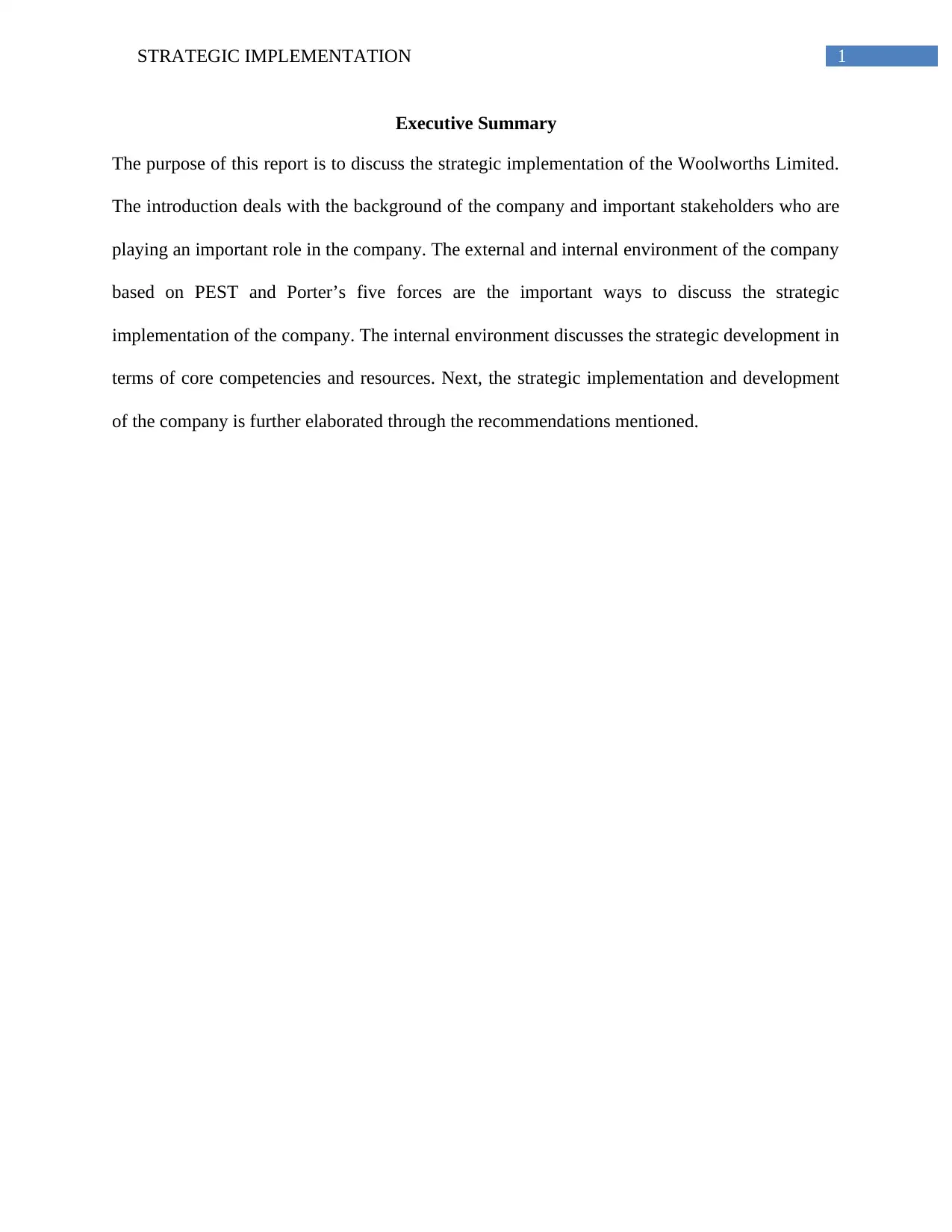
1STRATEGIC IMPLEMENTATION
Executive Summary
The purpose of this report is to discuss the strategic implementation of the Woolworths Limited.
The introduction deals with the background of the company and important stakeholders who are
playing an important role in the company. The external and internal environment of the company
based on PEST and Porter’s five forces are the important ways to discuss the strategic
implementation of the company. The internal environment discusses the strategic development in
terms of core competencies and resources. Next, the strategic implementation and development
of the company is further elaborated through the recommendations mentioned.
Executive Summary
The purpose of this report is to discuss the strategic implementation of the Woolworths Limited.
The introduction deals with the background of the company and important stakeholders who are
playing an important role in the company. The external and internal environment of the company
based on PEST and Porter’s five forces are the important ways to discuss the strategic
implementation of the company. The internal environment discusses the strategic development in
terms of core competencies and resources. Next, the strategic implementation and development
of the company is further elaborated through the recommendations mentioned.

2STRATEGIC IMPLEMENTATION
Table of Contents
1. Introduction..................................................................................................................................3
2. External Analysis of Woolworths................................................................................................3
a. PEST analysis of Woolworths.................................................................................................3
b. Porter’s five forces...................................................................................................................5
c. Opportunities based on three essential external factors...........................................................6
3. Internal Analysis of Woolworths.................................................................................................6
a. Core Competencies..................................................................................................................6
b. Resources.................................................................................................................................7
c. Strengths of Woolworths Organization...................................................................................7
4. Development of Strategy.............................................................................................................8
a. Strategy of the company..........................................................................................................8
b. Analyzing the strategies...........................................................................................................8
5. Implementation of Strategy.........................................................................................................8
a. Strategy implementation..........................................................................................................8
6. Recommendations........................................................................................................................9
a. Possible Alternatives................................................................................................................9
b. Further Recommendations.......................................................................................................9
7. Conclusion...................................................................................................................................9
8. References..................................................................................................................................10
Table of Contents
1. Introduction..................................................................................................................................3
2. External Analysis of Woolworths................................................................................................3
a. PEST analysis of Woolworths.................................................................................................3
b. Porter’s five forces...................................................................................................................5
c. Opportunities based on three essential external factors...........................................................6
3. Internal Analysis of Woolworths.................................................................................................6
a. Core Competencies..................................................................................................................6
b. Resources.................................................................................................................................7
c. Strengths of Woolworths Organization...................................................................................7
4. Development of Strategy.............................................................................................................8
a. Strategy of the company..........................................................................................................8
b. Analyzing the strategies...........................................................................................................8
5. Implementation of Strategy.........................................................................................................8
a. Strategy implementation..........................................................................................................8
6. Recommendations........................................................................................................................9
a. Possible Alternatives................................................................................................................9
b. Further Recommendations.......................................................................................................9
7. Conclusion...................................................................................................................................9
8. References..................................................................................................................................10
⊘ This is a preview!⊘
Do you want full access?
Subscribe today to unlock all pages.

Trusted by 1+ million students worldwide

3STRATEGIC IMPLEMENTATION
1. Introduction
Woolworths Limited in the year 1931 opened its door to the public in the Cape Town of
Australia. The founder of Woolworths Limited is Max Sonnenberg. The Company is having an
extensive interest in retail throughout the countries such as Australia and New Zealand. It is
regarded as the second largest company in Australia in terms of revenue after the retail based
market Conglomerate West Farmers. The main operations of the company incorporate
supermarkets (Woolworthsgroup.com., 2017) The important stakeholders and players of the
Woolworths Limited are employees, customers, shareholders, suppliers, government, franchisee,
unions, media organized business, interest groups and community groups and other non-
governmental organizations. The recent changes in the Woolworths organization are the private
changes in label, which is a response to the popularity of Aldi where the company is struggling
with the decreasing growth of sales. The recent performance of Woolsworth is to catch up with
Coles with its turnaround plan where the supermarket is trying to close the gap with the Coles
supermarket in the financial year of the first three months. It has maintained its trading
performance till now and continue to rise in future (Woolworthsgroup.com., 2017)
2. External Analysis of Woolworths
a. PEST analysis of Woolworths
Political: Woolworths is an important organization, which is fulfilling the demands of the
customers through the different outlets of retail (Gupta, 2013). The country’s political
environment is associated with the organization’s performance and the retail based companies
1. Introduction
Woolworths Limited in the year 1931 opened its door to the public in the Cape Town of
Australia. The founder of Woolworths Limited is Max Sonnenberg. The Company is having an
extensive interest in retail throughout the countries such as Australia and New Zealand. It is
regarded as the second largest company in Australia in terms of revenue after the retail based
market Conglomerate West Farmers. The main operations of the company incorporate
supermarkets (Woolworthsgroup.com., 2017) The important stakeholders and players of the
Woolworths Limited are employees, customers, shareholders, suppliers, government, franchisee,
unions, media organized business, interest groups and community groups and other non-
governmental organizations. The recent changes in the Woolworths organization are the private
changes in label, which is a response to the popularity of Aldi where the company is struggling
with the decreasing growth of sales. The recent performance of Woolsworth is to catch up with
Coles with its turnaround plan where the supermarket is trying to close the gap with the Coles
supermarket in the financial year of the first three months. It has maintained its trading
performance till now and continue to rise in future (Woolworthsgroup.com., 2017)
2. External Analysis of Woolworths
a. PEST analysis of Woolworths
Political: Woolworths is an important organization, which is fulfilling the demands of the
customers through the different outlets of retail (Gupta, 2013). The country’s political
environment is associated with the organization’s performance and the retail based companies
Paraphrase This Document
Need a fresh take? Get an instant paraphrase of this document with our AI Paraphraser
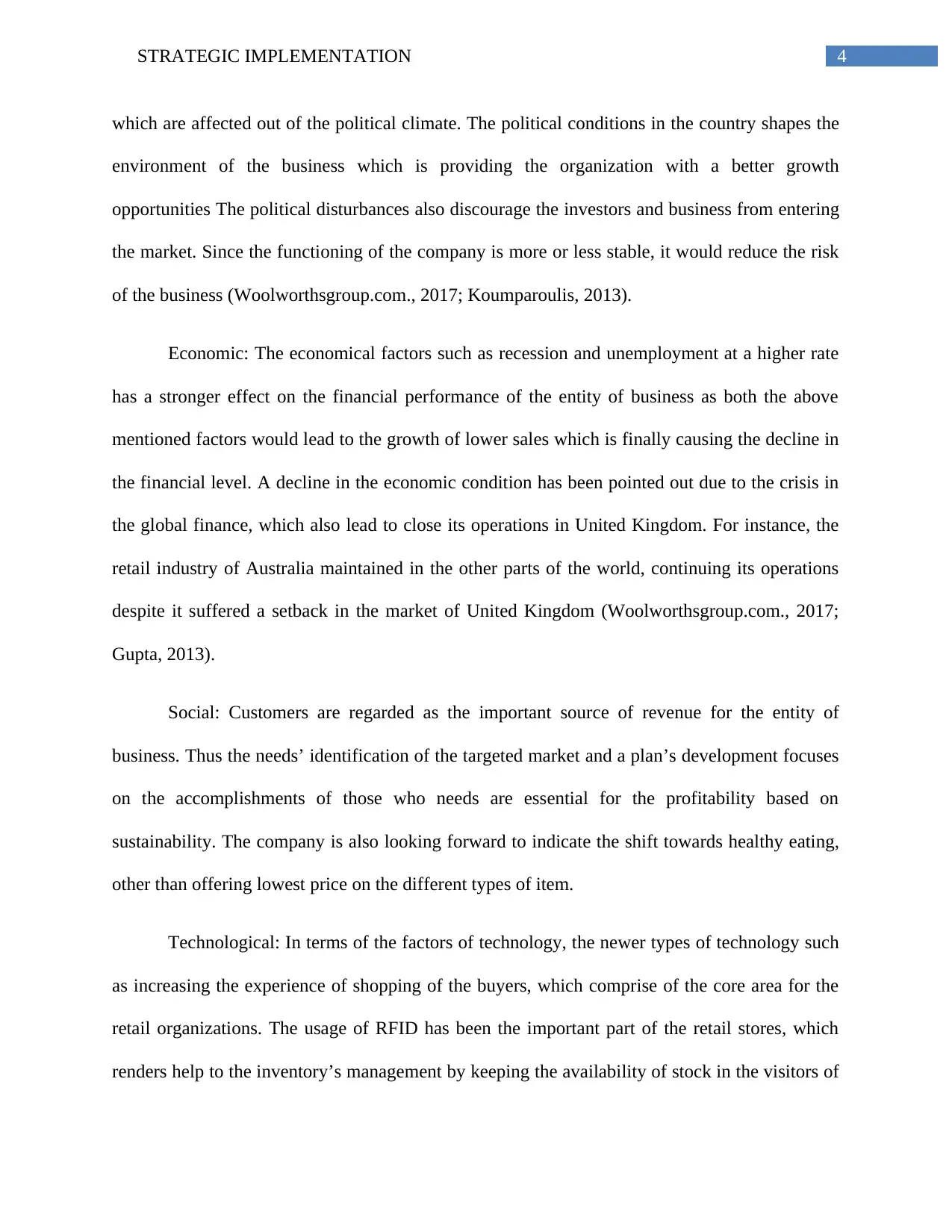
4STRATEGIC IMPLEMENTATION
which are affected out of the political climate. The political conditions in the country shapes the
environment of the business which is providing the organization with a better growth
opportunities The political disturbances also discourage the investors and business from entering
the market. Since the functioning of the company is more or less stable, it would reduce the risk
of the business (Woolworthsgroup.com., 2017; Koumparoulis, 2013).
Economic: The economical factors such as recession and unemployment at a higher rate
has a stronger effect on the financial performance of the entity of business as both the above
mentioned factors would lead to the growth of lower sales which is finally causing the decline in
the financial level. A decline in the economic condition has been pointed out due to the crisis in
the global finance, which also lead to close its operations in United Kingdom. For instance, the
retail industry of Australia maintained in the other parts of the world, continuing its operations
despite it suffered a setback in the market of United Kingdom (Woolworthsgroup.com., 2017;
Gupta, 2013).
Social: Customers are regarded as the important source of revenue for the entity of
business. Thus the needs’ identification of the targeted market and a plan’s development focuses
on the accomplishments of those who needs are essential for the profitability based on
sustainability. The company is also looking forward to indicate the shift towards healthy eating,
other than offering lowest price on the different types of item.
Technological: In terms of the factors of technology, the newer types of technology such
as increasing the experience of shopping of the buyers, which comprise of the core area for the
retail organizations. The usage of RFID has been the important part of the retail stores, which
renders help to the inventory’s management by keeping the availability of stock in the visitors of
which are affected out of the political climate. The political conditions in the country shapes the
environment of the business which is providing the organization with a better growth
opportunities The political disturbances also discourage the investors and business from entering
the market. Since the functioning of the company is more or less stable, it would reduce the risk
of the business (Woolworthsgroup.com., 2017; Koumparoulis, 2013).
Economic: The economical factors such as recession and unemployment at a higher rate
has a stronger effect on the financial performance of the entity of business as both the above
mentioned factors would lead to the growth of lower sales which is finally causing the decline in
the financial level. A decline in the economic condition has been pointed out due to the crisis in
the global finance, which also lead to close its operations in United Kingdom. For instance, the
retail industry of Australia maintained in the other parts of the world, continuing its operations
despite it suffered a setback in the market of United Kingdom (Woolworthsgroup.com., 2017;
Gupta, 2013).
Social: Customers are regarded as the important source of revenue for the entity of
business. Thus the needs’ identification of the targeted market and a plan’s development focuses
on the accomplishments of those who needs are essential for the profitability based on
sustainability. The company is also looking forward to indicate the shift towards healthy eating,
other than offering lowest price on the different types of item.
Technological: In terms of the factors of technology, the newer types of technology such
as increasing the experience of shopping of the buyers, which comprise of the core area for the
retail organizations. The usage of RFID has been the important part of the retail stores, which
renders help to the inventory’s management by keeping the availability of stock in the visitors of
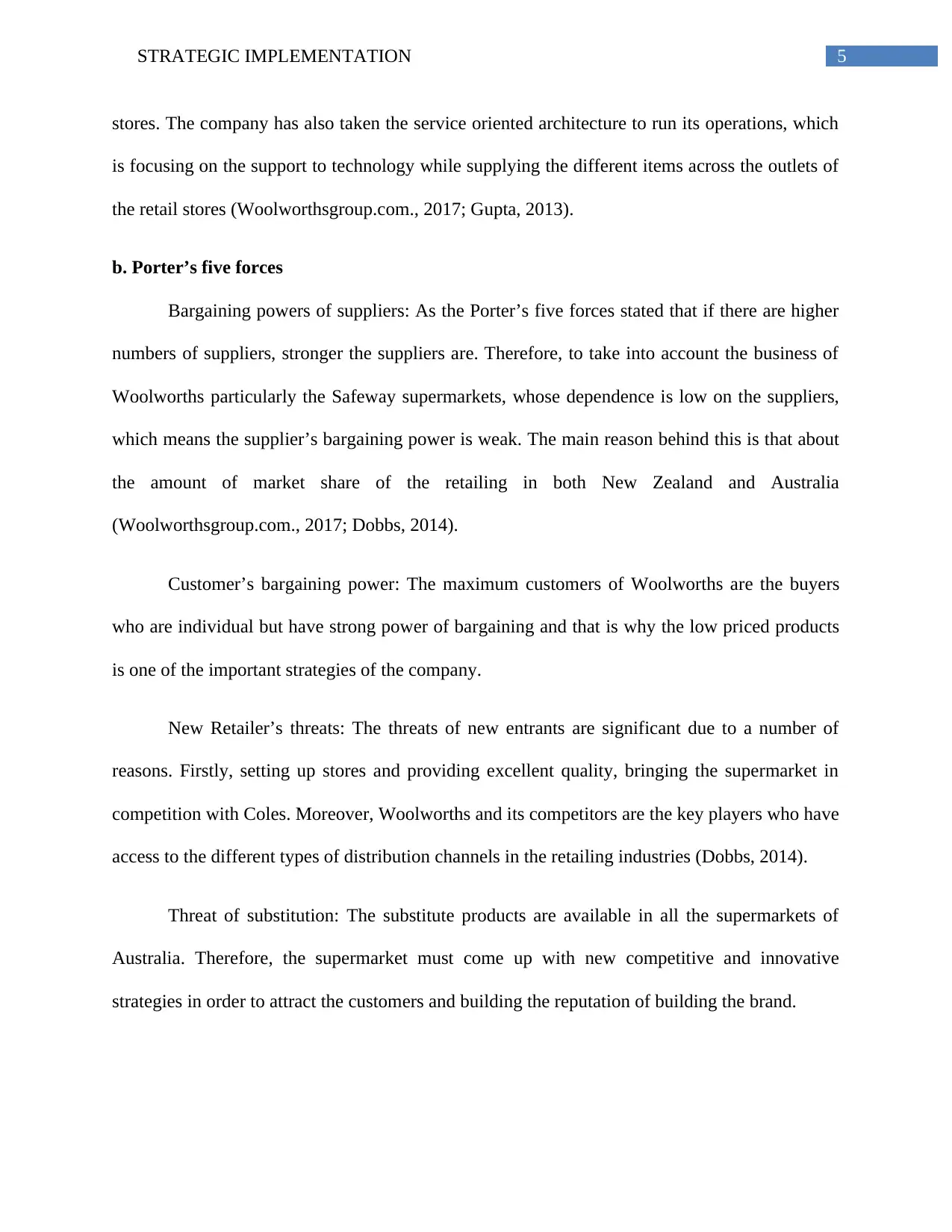
5STRATEGIC IMPLEMENTATION
stores. The company has also taken the service oriented architecture to run its operations, which
is focusing on the support to technology while supplying the different items across the outlets of
the retail stores (Woolworthsgroup.com., 2017; Gupta, 2013).
b. Porter’s five forces
Bargaining powers of suppliers: As the Porter’s five forces stated that if there are higher
numbers of suppliers, stronger the suppliers are. Therefore, to take into account the business of
Woolworths particularly the Safeway supermarkets, whose dependence is low on the suppliers,
which means the supplier’s bargaining power is weak. The main reason behind this is that about
the amount of market share of the retailing in both New Zealand and Australia
(Woolworthsgroup.com., 2017; Dobbs, 2014).
Customer’s bargaining power: The maximum customers of Woolworths are the buyers
who are individual but have strong power of bargaining and that is why the low priced products
is one of the important strategies of the company.
New Retailer’s threats: The threats of new entrants are significant due to a number of
reasons. Firstly, setting up stores and providing excellent quality, bringing the supermarket in
competition with Coles. Moreover, Woolworths and its competitors are the key players who have
access to the different types of distribution channels in the retailing industries (Dobbs, 2014).
Threat of substitution: The substitute products are available in all the supermarkets of
Australia. Therefore, the supermarket must come up with new competitive and innovative
strategies in order to attract the customers and building the reputation of building the brand.
stores. The company has also taken the service oriented architecture to run its operations, which
is focusing on the support to technology while supplying the different items across the outlets of
the retail stores (Woolworthsgroup.com., 2017; Gupta, 2013).
b. Porter’s five forces
Bargaining powers of suppliers: As the Porter’s five forces stated that if there are higher
numbers of suppliers, stronger the suppliers are. Therefore, to take into account the business of
Woolworths particularly the Safeway supermarkets, whose dependence is low on the suppliers,
which means the supplier’s bargaining power is weak. The main reason behind this is that about
the amount of market share of the retailing in both New Zealand and Australia
(Woolworthsgroup.com., 2017; Dobbs, 2014).
Customer’s bargaining power: The maximum customers of Woolworths are the buyers
who are individual but have strong power of bargaining and that is why the low priced products
is one of the important strategies of the company.
New Retailer’s threats: The threats of new entrants are significant due to a number of
reasons. Firstly, setting up stores and providing excellent quality, bringing the supermarket in
competition with Coles. Moreover, Woolworths and its competitors are the key players who have
access to the different types of distribution channels in the retailing industries (Dobbs, 2014).
Threat of substitution: The substitute products are available in all the supermarkets of
Australia. Therefore, the supermarket must come up with new competitive and innovative
strategies in order to attract the customers and building the reputation of building the brand.
⊘ This is a preview!⊘
Do you want full access?
Subscribe today to unlock all pages.

Trusted by 1+ million students worldwide

6STRATEGIC IMPLEMENTATION
Rivalry among competitors: The presence of the strong competitors in the retail stores of
Australia and the grocery industries are trying to limit the market share of Woolworths and to the
higher level of concentration (Dobbs, 2014)
c. Opportunities based on three essential external factors
In terms of politics, there is a political stability in the country Australia, therefore, the
country can do its business properly without any external political problems and can
further dig out the opportunities for further expansion (Woolworthsgroup.com., 2017).
In terms of technology, the future of the organization can be reshaped through the
presence of computerization, which would lead to the development of technology and
manufacturing industries and the lifestyle changes of the customers. This in future would
develop the country’s economy at a higher pace.
As Woolworth is increasing its shift to the healthier food, as discussed in the PEST
analysis, the fresh food future program would provide an opportunity for the new farming
sustainability and productivity for a longer period of time (Woolworthsgroup.com., 2017;
Hollenson, 2015).
3. Internal Analysis of Woolworths
a. Core Competencies
Woolworth’s organization is not able to counteract the competition from the list of
discounters, killer of category and specialists; they lacked a range of capabilities and
understandings of the structure of market that they are capable of challenging them once the
supermarket becomes an established one (Drucker, 2017). However, there are several core
competencies some of which are regarded as historic and others are adapted over the times by
Rivalry among competitors: The presence of the strong competitors in the retail stores of
Australia and the grocery industries are trying to limit the market share of Woolworths and to the
higher level of concentration (Dobbs, 2014)
c. Opportunities based on three essential external factors
In terms of politics, there is a political stability in the country Australia, therefore, the
country can do its business properly without any external political problems and can
further dig out the opportunities for further expansion (Woolworthsgroup.com., 2017).
In terms of technology, the future of the organization can be reshaped through the
presence of computerization, which would lead to the development of technology and
manufacturing industries and the lifestyle changes of the customers. This in future would
develop the country’s economy at a higher pace.
As Woolworth is increasing its shift to the healthier food, as discussed in the PEST
analysis, the fresh food future program would provide an opportunity for the new farming
sustainability and productivity for a longer period of time (Woolworthsgroup.com., 2017;
Hollenson, 2015).
3. Internal Analysis of Woolworths
a. Core Competencies
Woolworth’s organization is not able to counteract the competition from the list of
discounters, killer of category and specialists; they lacked a range of capabilities and
understandings of the structure of market that they are capable of challenging them once the
supermarket becomes an established one (Drucker, 2017). However, there are several core
competencies some of which are regarded as historic and others are adapted over the times by
Paraphrase This Document
Need a fresh take? Get an instant paraphrase of this document with our AI Paraphraser

7STRATEGIC IMPLEMENTATION
utilizing promotional strategies, offerings of products and prices. Woolworths adapted different
product, prices and technologies. The organization has been using the strategy of low price
system, which is regarded as the core competency of the firm. Another important success factors
are the channels of distribution. It is regarded as one of the important chain distributors in the
United Kingdom (Drucker, 2017).
b. Resources
The resources that Woolworths company is having are the
Retail Management Resources which includes Profit centre of Retailer’s, online financial
training of the retail and the owners institute of the retail.
Operation resources include the online digital retail and the foundation based on loss
prevention (Menther, Hamann & Nilsson, 2015).
Information for the Growth management of retail stores which includes customer
services, fixtures of stores, locations about stores, retail personnel store’s security system
and the software for stores based on accounting (Woolworthsgroup.com., 2017).
c. Strengths of Woolworths Organization
Most of the business of Woolworths have presented about the past few years with the
growth of the sales. On the basis of the resources, the company has the ability for
capital generation and in this case, the firm has the plan to expand their market by
opening more stores and updating facilities (Menther, Hamann & Nilsson, 2015).
The organization developed a long-term relationship with the suppliers and
producers. The organization developed a charter on fair trade, which encapsulates the
key principles of the business relationship with retailers.
utilizing promotional strategies, offerings of products and prices. Woolworths adapted different
product, prices and technologies. The organization has been using the strategy of low price
system, which is regarded as the core competency of the firm. Another important success factors
are the channels of distribution. It is regarded as one of the important chain distributors in the
United Kingdom (Drucker, 2017).
b. Resources
The resources that Woolworths company is having are the
Retail Management Resources which includes Profit centre of Retailer’s, online financial
training of the retail and the owners institute of the retail.
Operation resources include the online digital retail and the foundation based on loss
prevention (Menther, Hamann & Nilsson, 2015).
Information for the Growth management of retail stores which includes customer
services, fixtures of stores, locations about stores, retail personnel store’s security system
and the software for stores based on accounting (Woolworthsgroup.com., 2017).
c. Strengths of Woolworths Organization
Most of the business of Woolworths have presented about the past few years with the
growth of the sales. On the basis of the resources, the company has the ability for
capital generation and in this case, the firm has the plan to expand their market by
opening more stores and updating facilities (Menther, Hamann & Nilsson, 2015).
The organization developed a long-term relationship with the suppliers and
producers. The organization developed a charter on fair trade, which encapsulates the
key principles of the business relationship with retailers.

8STRATEGIC IMPLEMENTATION
The success of the organization was the channels of distributions.
4. Development of Strategy
a. Strategy of the company
The strategy of the company is to develop a team, reducing the processing of the costs
improvements, Developing the brand based on cohesive, making the stores refreshed and
updating the offerings of product (Woolworthsgroup.com., 2017; Shore et al., 2017)
b. Analyzing the strategies
The main strategy of the company is to keep the customers in the first position and
accordingly they are looking forward to develop a team who can cooperate with each other and
making the brand of the store famous by serving the consumers. In order to update their offerings
they work on the innovations such as fresh sushi bars and serving fresh meat and fish to the
consumers daily (Woolworthsgroup.com., 2017). Through these activities, they want to make
their brand cohesive so that the customers are attracted to the products of the supermarkets.
5. Implementation of Strategy
a. Strategy implementation
Woolworths organization implement its strategy by involving themselves by creating a link with
their suppliers and the firm focuses on less cute of price and more on the strategies in order to
grow their sales of firm. In the future, they would implement strategy through the better use of
the data analytics also looking forward to invest bigger data and the implementation of the
strategic plan of four points (Woolworthsgroup.com., 2017).
The success of the organization was the channels of distributions.
4. Development of Strategy
a. Strategy of the company
The strategy of the company is to develop a team, reducing the processing of the costs
improvements, Developing the brand based on cohesive, making the stores refreshed and
updating the offerings of product (Woolworthsgroup.com., 2017; Shore et al., 2017)
b. Analyzing the strategies
The main strategy of the company is to keep the customers in the first position and
accordingly they are looking forward to develop a team who can cooperate with each other and
making the brand of the store famous by serving the consumers. In order to update their offerings
they work on the innovations such as fresh sushi bars and serving fresh meat and fish to the
consumers daily (Woolworthsgroup.com., 2017). Through these activities, they want to make
their brand cohesive so that the customers are attracted to the products of the supermarkets.
5. Implementation of Strategy
a. Strategy implementation
Woolworths organization implement its strategy by involving themselves by creating a link with
their suppliers and the firm focuses on less cute of price and more on the strategies in order to
grow their sales of firm. In the future, they would implement strategy through the better use of
the data analytics also looking forward to invest bigger data and the implementation of the
strategic plan of four points (Woolworthsgroup.com., 2017).
⊘ This is a preview!⊘
Do you want full access?
Subscribe today to unlock all pages.

Trusted by 1+ million students worldwide
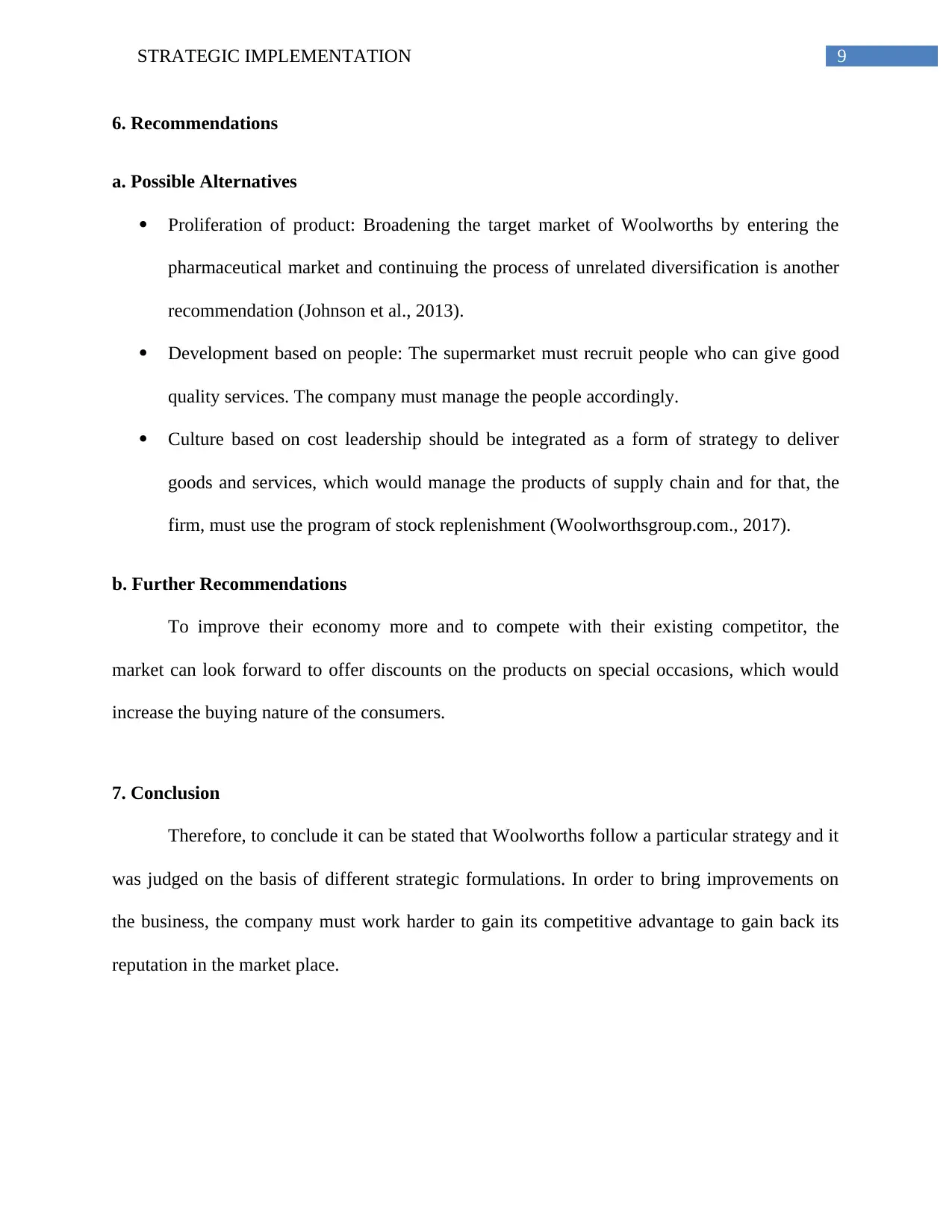
9STRATEGIC IMPLEMENTATION
6. Recommendations
a. Possible Alternatives
Proliferation of product: Broadening the target market of Woolworths by entering the
pharmaceutical market and continuing the process of unrelated diversification is another
recommendation (Johnson et al., 2013).
Development based on people: The supermarket must recruit people who can give good
quality services. The company must manage the people accordingly.
Culture based on cost leadership should be integrated as a form of strategy to deliver
goods and services, which would manage the products of supply chain and for that, the
firm, must use the program of stock replenishment (Woolworthsgroup.com., 2017).
b. Further Recommendations
To improve their economy more and to compete with their existing competitor, the
market can look forward to offer discounts on the products on special occasions, which would
increase the buying nature of the consumers.
7. Conclusion
Therefore, to conclude it can be stated that Woolworths follow a particular strategy and it
was judged on the basis of different strategic formulations. In order to bring improvements on
the business, the company must work harder to gain its competitive advantage to gain back its
reputation in the market place.
6. Recommendations
a. Possible Alternatives
Proliferation of product: Broadening the target market of Woolworths by entering the
pharmaceutical market and continuing the process of unrelated diversification is another
recommendation (Johnson et al., 2013).
Development based on people: The supermarket must recruit people who can give good
quality services. The company must manage the people accordingly.
Culture based on cost leadership should be integrated as a form of strategy to deliver
goods and services, which would manage the products of supply chain and for that, the
firm, must use the program of stock replenishment (Woolworthsgroup.com., 2017).
b. Further Recommendations
To improve their economy more and to compete with their existing competitor, the
market can look forward to offer discounts on the products on special occasions, which would
increase the buying nature of the consumers.
7. Conclusion
Therefore, to conclude it can be stated that Woolworths follow a particular strategy and it
was judged on the basis of different strategic formulations. In order to bring improvements on
the business, the company must work harder to gain its competitive advantage to gain back its
reputation in the market place.
Paraphrase This Document
Need a fresh take? Get an instant paraphrase of this document with our AI Paraphraser

10STRATEGIC IMPLEMENTATION
8. References
Drucker, P. F. (2017). The Theory of the Business (Harvard Business Review Classics). Harvard
Business Press.
E. Dobbs, M. (2014). Guidelines for applying Porter's five forces framework: a set of industry
analysis templates. Competitiveness Review, 24(1), 32-45.
Gupta, A. (2013). Environmental and pest analysis: An approach to external business
environment. Merit Research Journal of Art, Social Science and Humanities, 1(2), 13-17.
Hollensen, S. (2015). Marketing management: A relationship approach. Pearson Education.
Johnson, G., Whittington, R., Scholes, K., Angwin, D., & Regnér, P. (2013). Exploring strategy
text & cases (Vol. 10). Pearson.
Koumparoulis, D. N. (2013). PEST Analysis: The case of E-shop. International Journal of
Economy, Management and Social Sciences, 2(2), 31-36.
Methner, N., Hamann, R., & Nilsson, W. (2015). The Evolution of a Sustainability Leader: The
Development of Strategic and Boundary Spanning Organizational Innovation Capabilities
in Woolworths. In The Business of Social and Environmental Innovation (pp. 87-104).
Springer International Publishing.
Shore, A. D., Morton, A. G., Addison, A. F., Investments, A., Hahn, J., Read, A. G., ... &
Waterhouse,(2017) M. AGM reports published on the ASA website.
8. References
Drucker, P. F. (2017). The Theory of the Business (Harvard Business Review Classics). Harvard
Business Press.
E. Dobbs, M. (2014). Guidelines for applying Porter's five forces framework: a set of industry
analysis templates. Competitiveness Review, 24(1), 32-45.
Gupta, A. (2013). Environmental and pest analysis: An approach to external business
environment. Merit Research Journal of Art, Social Science and Humanities, 1(2), 13-17.
Hollensen, S. (2015). Marketing management: A relationship approach. Pearson Education.
Johnson, G., Whittington, R., Scholes, K., Angwin, D., & Regnér, P. (2013). Exploring strategy
text & cases (Vol. 10). Pearson.
Koumparoulis, D. N. (2013). PEST Analysis: The case of E-shop. International Journal of
Economy, Management and Social Sciences, 2(2), 31-36.
Methner, N., Hamann, R., & Nilsson, W. (2015). The Evolution of a Sustainability Leader: The
Development of Strategic and Boundary Spanning Organizational Innovation Capabilities
in Woolworths. In The Business of Social and Environmental Innovation (pp. 87-104).
Springer International Publishing.
Shore, A. D., Morton, A. G., Addison, A. F., Investments, A., Hahn, J., Read, A. G., ... &
Waterhouse,(2017) M. AGM reports published on the ASA website.
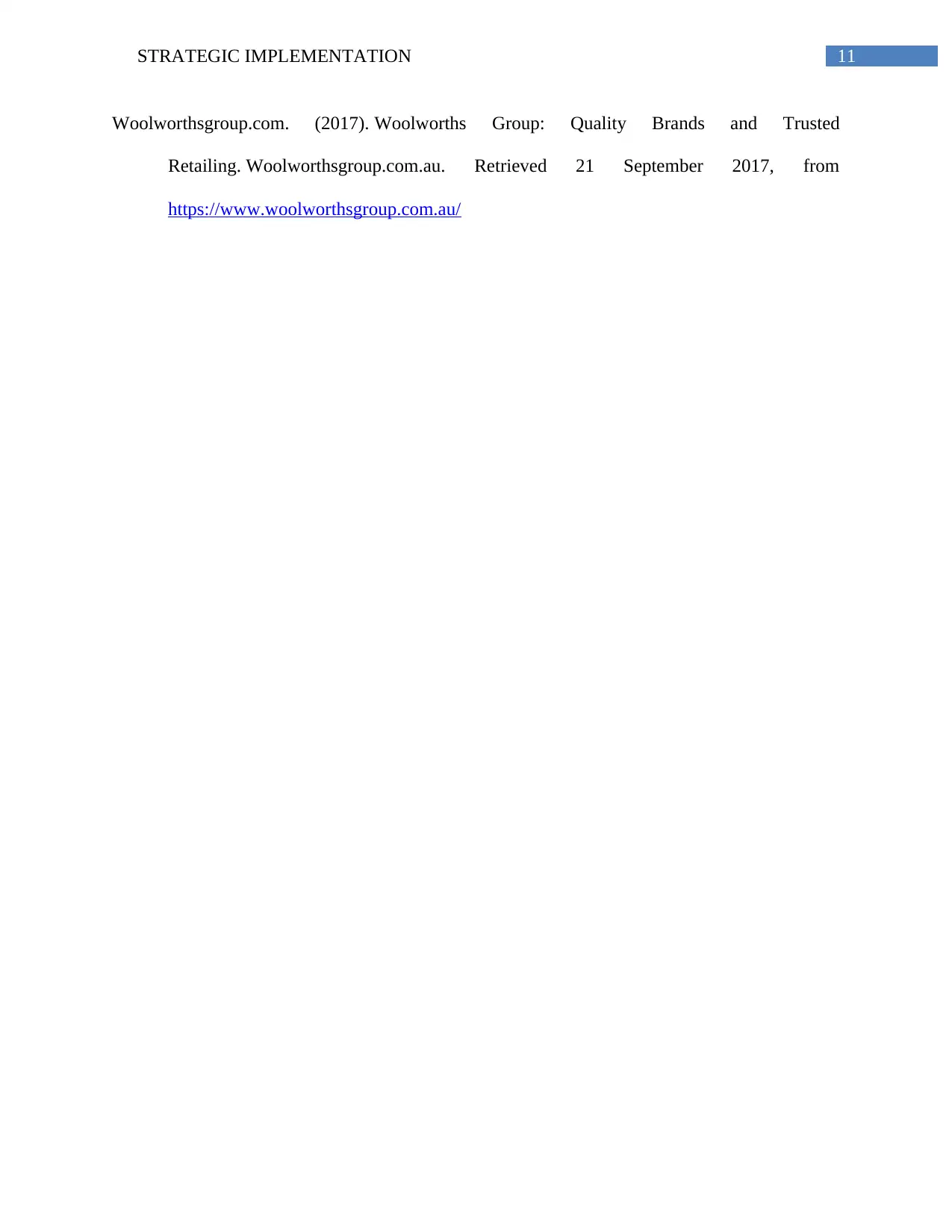
11STRATEGIC IMPLEMENTATION
Woolworthsgroup.com. (2017). Woolworths Group: Quality Brands and Trusted
Retailing. Woolworthsgroup.com.au. Retrieved 21 September 2017, from
https://www.woolworthsgroup.com.au/
Woolworthsgroup.com. (2017). Woolworths Group: Quality Brands and Trusted
Retailing. Woolworthsgroup.com.au. Retrieved 21 September 2017, from
https://www.woolworthsgroup.com.au/
⊘ This is a preview!⊘
Do you want full access?
Subscribe today to unlock all pages.

Trusted by 1+ million students worldwide
1 out of 12
Related Documents
Your All-in-One AI-Powered Toolkit for Academic Success.
+13062052269
info@desklib.com
Available 24*7 on WhatsApp / Email
![[object Object]](/_next/static/media/star-bottom.7253800d.svg)
Unlock your academic potential
Copyright © 2020–2025 A2Z Services. All Rights Reserved. Developed and managed by ZUCOL.



